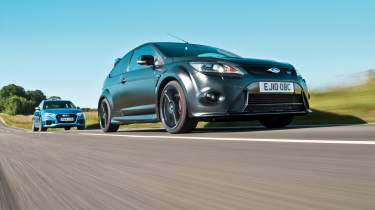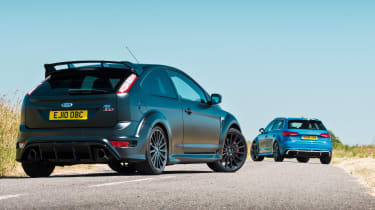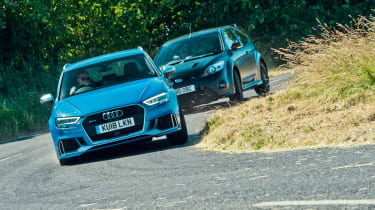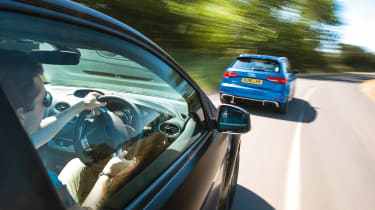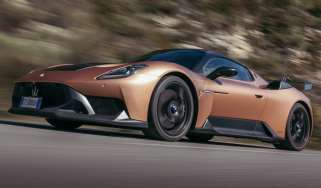Ford Focus RS500 v Audi RS3 – new v used
One’s an eight-year-old Ford, the other a brand new Audi. But which of these five‑cylinder superhatches deserves your £45k?
You know the premise of a ‘new versus used’ test: an older premium car with sophisticated mechanics and impressive performance gets pitted against a similarly priced new car that’s a little more basic and probably slower. Not this time.
As hatchbacks go, our new car, the Audi RS3, doesn’t get much faster, more premium or more sophisticated. It’s got it all: a 394bhp five-cylinder engine, four-wheel drive, a dual-clutch gearbox and adaptive dampers. And so it should for £44,755. By comparison the similarly priced Mk2 Ford Focus RS500 looks seriously lacking. The Ford may be fitted with a torque-biasing limited-slip differential and RevoKnuckle suspension – a modified MacPherson strut unit where only the hub carrier rotates when the steering is turned rather than the entire strut – but it is still only front-wheel drive and has, by today’s standards, a rather conventional six-speed manual gearbox.
It does offer a number of upgrades over an ordinary Mk2 Focus RS, of course, including an ECU tweak, an uprated fuel pump, a larger intercooler, a new airbox and exhaust, and the black wrap. But just as importantly, the RS500 is rare. Only 500 were built – hence its name – and just 101 stayed in the UK, and as a fast Ford it has the sort of passionate followers who make boy-band fans look apathetic. So most RS500s are valued at over £40,000 – more than twice the entry price of a regular Mk2 RS.
> 2019 Audi RS3 review – no longer the hottest of hatchbacks
Those upgrades, although not comprehensive, gave the 2.5-litre five-cylinder turbocharged engine an extra 45bhp and 15lb ft. That made it absurdly powerful when it came out in 2010, and it’s still incredibly impressive compared to today’s leading front-wheel-drive hot hatches, but with 345bhp it’s rather outgunned by the RS3. Then again, most things are.
Along with a handful of supercar engines and the occasional V8, the Audi’s five-cylinder is one of the most desirable engines available in any new car. The noise it makes is even more memorable than the car’s startling pace. It sounds more like an Ur-Quattro than an Ur-Quattro.
The motor really is a jewel in an already expensive-feeling package. This RS3 glitters thanks to its Ara Blue ‘crystal effect’ paint, bright aluminium trim and optional diamond-cut alloys, while inside there’s luxurious quilted leather and Audi’s high-tech Virtual Cockpit digital dash. It’s hardly the restrained look that fast Audis used to have but, oh my, it oozes quality and feels lavish.
The Audi’s interior needs to be plush and well finished, though, because you’ll be dedicating more of your attention to appreciating its finer elements than in most other hot hatches. Not because you’re travelling slowly, far, far from it, but because the RS3 doesn’t require superhuman levels of focus, deft inputs and every ounce of your skill to dispatch even the most demanding road. Regardless of how you choose to drive – calmly or aggressively – the RS3 behaves in the same fashion, remaining composed and resolutely stuck to the tarmac. Impressive, undoubtedly, and it’s hard to decide what’s more remarkable: the engine’s ballistic force or the way the chassis allows you to master any road with such absolute confidence. But the driver’s influence on the Audi’s attitude is minimal at best.
The Ford doesn’t look or feel like it’s worth even half the value of the RS3. Its big wing is crass and, because its wide arches aren’t totally filled by the wheels, it looks awkward, like a WRC car set up for Rally Finland with knobbly gravel tyres. Also, even a low-mileage example like this one can look scruffy. The 3M matt black wrap (Scotchcal Series 85, to be exact) is covered in fine scratches and at the corners and on ridges has gone shiny like the well-thumbed buttons of a TV remote. There are also ripples around the rear boot trim; it looks as though the screws that hold the handle on have snagged the wrap as they’ve been tightened up. It’s a common issue. It appears around the bonnet vents, too, and is due to the trim moving slightly and gathering the wrap. When under warranty, Ford rewrapped the problem panels, but the issues continued to happen. Most RS500s now have wraps made from newer, more advanced materials and installed by more experienced specialists. Many others simply run without a wrap – the glossy Panther Black paint beneath is far more durable and easier to repair.
The Focus is definitely neater inside than out, if a little bland and functional. There’s a wonderfully nostalgic and pixelly satnav screen to add an element of amusement, and despite the best efforts of a set of Recaro seats, a trio of supplementary dials and panels covered in tiny RS logos, the overall look isn’t too garish. However, there’s still nothing to suggest this is a car worth over £40k.
Even the engine doesn’t seem that exotic at first. After you’ve prodded the Focus’s starter button you realise you’ve been somewhat spoiled by the RS3’s pitch-perfect five-pot noise – at idle you just can’t tell that the RS500’s engine isn’t a more conventional turbo four. That distinct warble does come through when you open the throttle, though, and there’s a muted pop when you change gear that adds a satisfying end to the crescendo, but it can’t quite match the RS3’s tone. Try to stay on the Audi’s tail down a B-road, meanwhile, and you’ll have to muster up the sort of commitment that just isn’t appropriate for the road; the Focus simply doesn’t have the pace or grip to keep up.
Initially the Ford feels big and tall, and you can sense its body wanting to tip over as you corner, but the fixed-rate suspension manfully resists roll. It’s similar to the way the new Fiesta ST behaves, only the Focus is on a different scale in terms of size, sophistication and performance. It may ‘only’ be front-wheel drive and have substantial power, but the LSD is on top of everything when it comes to traction. The engine delivers its performance in one smooth flow, so once the front tyres are hooked up you can keep your foot firmly on the throttle. If you’re too greedy with the accelerator in slower corners you can get little bursts of wheelspin, and the LSD pulls and tugs slightly at the steering, but the RS500 isn’t as wild or untamed as the peak power figure and Mad Max exterior suggest.
Part of the Focus’s impressive traction, however, can be put down to its ability to carry speed through a corner, so you simply don’t need to accelerate all that hard as you exit. Both axles contribute, almost equally, to the way the Focus wants to hurry round a bend. As a result you use very little steering angle, just an initial tweak when you’re off the throttle to get the car to rotate, a bit of countersteer to stop it getting too wayward, then hold the wheel practically straight as the diff keeps the front wheels locked on line and the rears teeter on the edge of grip.
The more familiar you become with the Focus, the less steering you require – if you don’t turn in as aggressively you don’t need to correct as much – and it’s remarkable how you can manipulate the RS500 so significantly with such modest inputs. Powering out of a corner with no discernable lock applied feels like you’re piloting a pointy four-wheel-drive rally rep. The Focus almost feels more four-wheel drive than the RS3…
Despite both being five-cylinder hot hatches, each has opposing talents and thrives at what the other is poor at. Every Focus defect – its cheap feel and poor finish, subdued noise, plain interior and less-than-desirable image – is countered wholeheartedly by the RS3’s expensive aura. But nice leather, a fancy dash and an exquisite noise can only keep you occupied for so long, because no matter how hard you try, your influence on how the RS3 behaves is pretty minimal. The opposite is true for the Focus. You have to search for its gifts and why it might be worth so much money, but once you’ve discovered how the car responds to the tiniest of inputs it becomes endlessly fascinating on every drive you have in it.
Specifications and costs
| Ford Focus RS500 | Audi RS3 Sportback | |
| Engine | In-line 5-cyl, 2522cc, turbocharger | In-line 5-cyl, 2480cc, turbocharger |
| Power | 345bhp @ 6000rpm | 394bhp @ 5850-7000rpm |
| Torque | 339lb ft @ 2500-4500rpm | 354lb ft @ 1700-5850rpm |
| Transmission | Six-speed manual, front-wheel drive | Seven-speed dual-clutch, four-wheel drive |
| Weight | 1467kg | 1510kg |
| Power-to-weight | 239bhp/ton | 265bhp/ton |
| 0-62mph | 5.6sec | 4.1sec |
| Top speed | 165mph | 155mph (limited) |
| Price new | £35,750 (2010) | £44,755 |
| Value today | £40,000-50,000 | - |
| Short service | £249 | Oil and inspection service - £235 |
| Full service | £339 | Oil change service - £340 |
| Front discs | £165.31 pair | £700 pair |
| Front pads | £199.58 per axle set | £500 per axle set |
| Rear discs | £70.87 pair | £218 pair |
| Rear pads | £77.93 per axle set | £232 per axle set |
| Clutch | £999 (fitted) | - |
| Tyres | £162.30 each, front and rear(Continental Sport Contact 3) | £204.43 each, front and rear (Pirelli P Zero) |
| Insurance | £425 (£300 excess) | £450 (£400 excess) |
The rivals
A £40,000, limited-production, front-wheel-drive hot hatch is a rare thing, but there is one car that shares the RS500’s attributes – the Volkswagen Golf GTI Clubsport S. There are still some very low-mileage examples of the pared-back Ring-record hatchback that command RS500 levels of cash, while ones with a few thousand miles on the clock are a bit more affordable.
The RS3 is similarly short on direct rivals. Only one other new car gets close on power, price, performance and pedigree – the Mercedes-AMG A45. The Affalterbach hatch is just as grippy and secure, and although it’s a little down on power at 376bhp, you wouldn’t know from behind the wheel. However, the four-pot A-class doesn’t make half as good a noise as the five-cylinder Audi.
Cheaper new hot hatches, ones that also don’t quite reach the RS3’s levels of power, offer an opportunity to spend whatever’s left over on bumping up the performance. A new Golf R with Revo modifications or a Birds-tuned BMW M140i have the potential to be more fun, too.
For this sort of money you can also bag a real hot hatch icon. Very clean Renault Sport Clio V6s with 30,000 miles or less are on sale for £40,000 or thereabouts. If you’re swayed by rally pedigree you might want to spend your money on a Lancia Delta Integrale Evo II or, for Ford fans, a very nice Escort RS Cosworth.
If all you crave is a quintet of cylinders you won’t need to spend your full £40,000. A fraction of your budget will get you a Fiat Coupe Turbo, Volvo 850 R, Mk2 Ford Focus ST or regular Mk2 Focus RS. Closer in terms of performance to the RS3 would be an Audi TT RS, or if you want the exclusivity of the RS500 you could consider an Audi Quattro or RS2; for good examples of all of those you’ll need the full £40,000, if not a little more.
Ford Focus RS - expert view
Fred Clack of Mountune: ‘Pretty much all the mechanical issues an RS500 might have are ones the regular Mk2 RS could suffer from too – they’re virtually the same car – and there are some inherent problems most examples have. One is the plastic inlet plenum: they crack where the brake servo vacuum joins the manifold. I’ve seen them go on standard cars, but any uprated car with a bit more boost pressure is prone to cracking. They don’t always just split, I’ve seen them literally explode. If it does go, you lose your brake servo instantly and your brake pedal goes rock-hard, and in the worse cases the engine can draw some of the plastic into the inlet ports. It’s the reason why we and other companies offer a cast-aluminium inlet.
‘Another common fault is with the oil filter breather. The crankcase breathing system is in the same housing as the oil filter; the top part of that is plastic, the rest is aluminium, and the seal between the two can leak. When it does, because it’s tied in with the crankcase venting, it can draw in air and the idle can be erratic. I’ve seen some cars where it never seems to get any worse and others where it absolutely needs replacing because the car is idling so badly and it’s leaking oil quite heavily. If you put a Ford one on, I can guarantee in a year’s time it’s going to start leaking again. We don’t offer an upgrade, but there are a lot of other oil filter bodies out there.
‘A really common problem I’ve seen loads of over the years is the PCM [powertrain control module]. If a customer rings and says his Mk2 RS doesn’t start and he’s got loads of error messages on the screen, nine times out of ten it’s a PCM failure. There’s no real fix for it and all the passive anti-theft data is on there so a new one has to be programmed to the car, plus whatever calibration or map you’re running is on there too. If I bought a Mk2 RS, I would buy a spare PCM and have it sitting there all loaded up so you can just swap it over.
‘The standard ABS cables are a little bit too short, possibly because of the geometry change for the RevoKnuckle front end. If the suspension is on full droop, it starts to stretch the cables. If the ABS light’s on you can almost guarantee it’s damaged cables.
‘The drivetrain is a very strong point of the car and if it’s been well looked after it’ll pull like a train. That five-cylinder Duratec engine is really strong, and the gearbox I wouldn’t say is bulletproof, but it’s pretty good. However, the driveshaft joints wear and that creates a vibration. Driveshafts are pretty expensive, but the more power you put through a drivetrain, more and more weak points are going to show up.’
